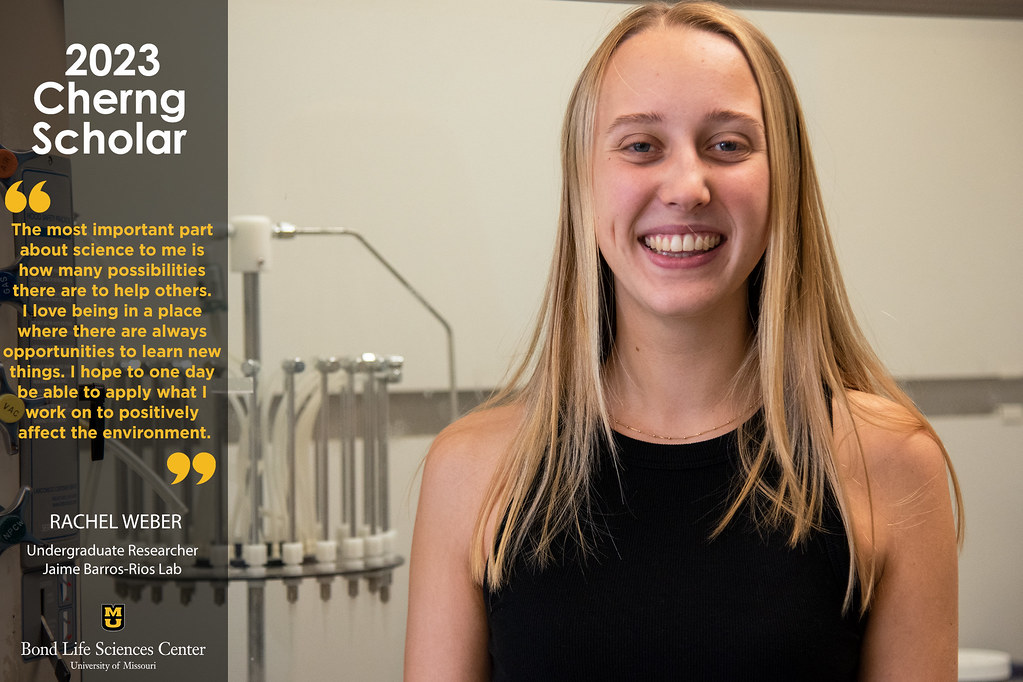News
Cherng Scholar Rachel Weber
A strong, stable stem is like Rachel Weber’s career in plant biology.
Weber started in a research lab only a few months after she stepped onto the University of Missouri campus for the first time.
“I was really excited and surprised because I didn’t expect as a freshman to have this opportunity,” Weber said.
Weber began by studying lignin with Jaime Barros-Rios, an assistant professor in the Division of Plant Science & Technology at MU.
Now, she is continuing her lab experience as one of fourteen Cherng Summer Scholarship recipients for a nine-week, full-time program through the MU Honors College. The scholarship supports undergraduate research projects, with a $7,000 award and $1,000 expense account, so Weber can continue her work at Bond LSC. She started under the Barros-Rios lab at Bond LSC in October 2022, where she will continue as a Cherng Scholar.
The Freshman Research in Plants (FRIPS) program gave Weber this chance. The program encourages student involvement in plant biology as soon as they reach campus to start a potential career in the field right away.
“You just have to go for it because it’s really just about how passionate you are and how hard you try,” Weber said. “If you look for the opportunity, you can find it.”
Plants were once fragile and flimsy, unable to hold themselves up, but 450 million years ago lignin and the enzymes that accompany it evolved to stiffen plant cell walls to allow plants to flourish.
Lignin – a large chain polymer – is comprised of three main sub-units that are the product of a complex pathway of compounds. These compounds are being converted into components of living organisms. These sub-units occur in different ratios depending on the plant and impact the chemical properties of the plant’s cell wall. Lignin has proven to be a limiting factor in the production of certain biofuels due to the chemical makeup of the polymer, which is why it is so important to understand how it is constructed.
Along with having an impact on the biofuels industry, “lignin helps plants respond to different stressors, so understanding it has a lot of implications in grasping how the plant survives and how it responds to different environmental factors,” Weber said.
Weber’s research project digs into the way two enzymes interact and how they work together to synthesize lignin. Laccases and peroxidases are enzymes that oxidize the sub-units of lignin to come together and form the larger lignin polymer. Both enzymes use reactive oxygen species (ROS) as a substrate, but their individual role in the polymerization process of lignin is unknown.
The mystery comes down to how 17 laccases and more than 60 peroxidases in Arabidopsis plants work to develop lignin. Weber aims to crack the code on what makes the functions of these enzymes so special. To Weber, this means investigating plant stems and roots.
“Not every gene has been characterized for these enzymes and the fact that there are multiple enzymes with potentially the same function makes it hard to determine their specific roles,” Weber said. “This also means that if you knockout one enzyme, another one may take its place and that may make no difference to the plant, we just don’t know that yet.”
Weber plans to utilize two mutant Arabidopsis plants with one not displaying a certain laccase and the other not containing a peroxidase. This will allow her to observe the enzymes’ individual roles in the plant’s lignin and compare their impact on the plant’s noticeable characteristics. This process brings Weber back to her agriculture roots. Weber spent time at her grandparents’ farm growing up, and she learned to admire the biological complexity of nature. She now sees more of that interwoven fabric with the effects of climate change.
“My grandparents are farmers, so I see how the current drought we are under is adding stress to their lives and impacting their livelihood,” she said. “The fact that many researchers are working on drought resistant crops is really encouraging and exciting to me and I hope to be able to have a similar impact on others.”
Weber spent anywhere from 10 to 15 hours a week in the Barros-Rios lab during the school year, but her part-time research project will now turn into a 40-hour work week. To establish what role each enzyme plays in lignin, Weber will test the waters with protocols to analyze these mutant plants. This includes measuring the composition of subunits of lignin, looking at levels of reactive oxygen species, and utilizing microscopy techniques to visualize the lignin polymer in plants.
Weber chose plant biology to actively alleviate climate change’s effects one step at a time and to fulfill a small role in a large and complex issue within the biofuel and biomaterials industries. This field grants her the resources and support to see how one polymer, or a group of enzymes, can help other researchers grasp the nature of lignin more fully.
“The most important part about science to me is how many possibilities there are to help others. I love being in a place where there are always opportunities to learn new things,” Weber said. “I hope to one day be able to apply what I work on to positively affect the environment.”
